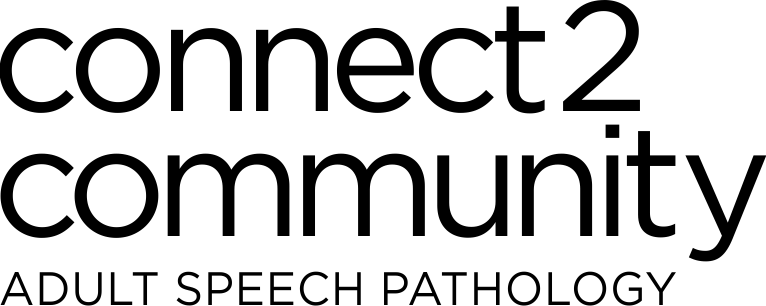

Dysphagia
What is dysphagia? dis-FAH-juh
Dysphagia is simply defined as a disorder of, or difficulty with, swallowing. More specifically, dysphagia is any problem with swallowing, drinking, chewing, eating, controlling saliva, taking medication and protecting the lungs from food and drink ‘going down the wrong way’. Dysphagia can have a significant influence on a person’s health and overall quality of life. From a medical point of view, dysphagia can result in foods or liquids entering the airway (i.e., breathing tube) instead of the oesophagus (i.e., food tube), resulting in a choking and/or aspiration pneumonia, both of which can be fatal. Dysphagia can also lead to dehydration and undernutrition resulting in further medical compromise. The psychosocial consequences of dysphagia can impact both the person with dysphagia and those in a caregiver role. The impact of swallowing conditions can be short or long term.
Depending on which part of the swallowing process is affected, dysphagia can be described as:
- Oral dysphagia: when the swallowing problem is in the mouth (e.g., reduced movement of the tongue)
- Pharyngeal or oropharyngeal dysphagia: when the problem is specific to food/fluids passing through the throat
- Oesophageal dysphagia: when food/fluid is difficult to move down through the oesophagus and into the stomach
What are signs and symptoms of swallowing difficulties?
Early identification is very important. If you notice any of the signs or symptoms below, please make an appointment to see a speech pathologist.
- Coughing, choking or frequent throat clearing during or after eating and drinking;
- Frequent chest infections with no known cause;
- Becoming short of breath or your breathing changing when eating and drinking;
- A feeling of food or drink being stuck in the throat. A feeling that food or fluid is going the wrong way;
- Avoiding certain foods because they are difficult to swallow;
- Unplanned weight loss or failing to put on weight due to avoidance of certain foods or finding it hard to eat or chew food
- Long mealtimes or eating slowly (it takes more than 30 minutes to finish a meal)
Swallowing Phases
- Pre-oral phase involves the cognitive (thinking) response to food and fluid and the ability of the person to think about eating. This is largely a sensory phase of swallowing.
- Oral preparatory phase and oral phase of the swallow starts as the bolus of food or fluid moves through the open lips. Food and liquid is chewed and mixed with saliva and then pushed into the pharynx (throat region) by the tongue (the tongue works to move the food back towards the throat)
- Pharyngeal phase of swallowing is where the soft palate elevates and creates pressure within, so food doesn’t go back into the nose. The food or fluid reaches the pharynx (back of the throat) and triggers the swallow reflex. The swallow reflex acts to protect the airway so that food or fluid passes into the oesophagus and not into the lungs.
- Oesophageal phase of swallowing begins when food or fluid enters the oesophagus – the tube that carries food and fluid to the stomach. The oesophagus has two important muscles (or sphincters) that open and close reflexively as the food or fluid bolus is squeezed downwards to the stomach. These sphincters ensure the food of fluid bolus flows in the forward direction.
What causes dysphagia?
Acquired dysphagia in adults can be caused by a range of medical and physical conditions.
Dysphagia can arise because of:
- Neurological changes affecting the nervous system (e.g., stroke, traumatic brain injury)
- Progressive neurological changes affecting the nervous system (e.g., motor neuron disease, Parkinson’s disease, Parkinsonian syndromes such as progressive supranuclear palsy, dementia),
- Iatrogenic changes as a side effect of (e.g., medications, surgical procedures, radiation therapy, thermal burns, dental and facial trauma, oral intubation or tracheostomy)
- Structural changes (e.g., head and neck cancer)
- Genetic conditions: (e.g., Huntington’s disease)
- Older age-related changes
- Pulmonary disease (e.g., chronic obstructive pulmonary disease)
- Gastroesophageal reflux disease (GERD)
- Decompensation/frailty
- Spinal cord injury
- Cardiothoracic surgery
It’s important to know the following:
- Early identification and management of dysphagia is critical to prevent or minimise complications.
- Speech pathologists have an in-depth knowledge of the nerves and muscles used for swallowing and how they are affected by medical conditions
- Speech pathologists work with other health professionals such as medical (e.g., GPs, ENT’s, Gastroenterologists), dieticians, occupational therapists, physiotherapists, radiologists, nurses, pharmacists as part of a multidisciplinary team to best support the patient with dysphagia.
- Further referral for swallow function investigation such as an instrumental assessment may be required:
- A videofluoroscopic swallow study (VFSS) is a moving X-ray image that shows how the muscles in the mouth, throat, and upper oesophageal sphincter function during swallowing. The procedure involves swallowing a white liquid called barium (mixed in with food and/or fluids) and then taking X-rays of the swallow.
- A fibreoptic endoscopic evaluation of swallowing (FEES) test is a procedure used to assess how well you swallow. During the procedure, a speech pathologist passes a thin, flexible instrument through your nose. Then the speech pathologist views parts of your throat as you swallow.
A speech pathologist can:
- Identify a holistic profile of a client’s swallowing function and needs
- Collaborate with client and family members towards person-centered therapy goals
- Discuss treatment options specific to the client’s swallowing function, needs and goals
- Provide treatment that meets the client’s swallowing needs and goals with all treatments focusing on real-life, meaningful activities and roles.
- Provide caregiver education and training specific to safe swallow strategies and food and fluid texture modifications
- Identify barriers and facilitators within the person’s environment, with the goal being – how to best support the client and family’s participation in the mealtime environment.
- Provide dysphagia specific education for the client and family
Speech pathologists are trained to assess, diagnose, provide treatment and advocate for people with dysphagia. Please contact connect2community speech pathology if you have any concerns or questions regarding dysphagia or a recent diagnosis of dysphagia.
PHONE 0411 864 386
EMAIL info@connect2community.au
